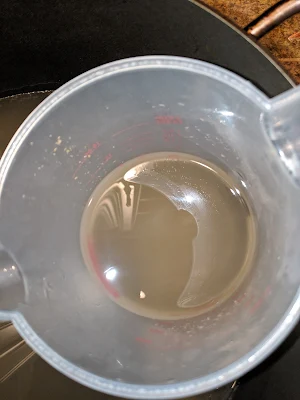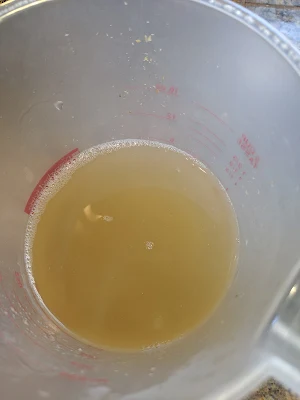 |
| Aged hops |
Otherwise my goal with this batch is to continue dialing in the appropriate ambient temperature to cool these small batches of spontaneous beer. My first several attempts at coolshipping beer did not turn out great and I believe the colder temperatures played at least some role. The most recent one gallon batch, which I cooled at warmer temperatures, fermented quicker and more vigorously than the earlier batches. Ideally I would like to find the technique that allows for a higher volume of aged hops than a paltry 0.15 oz/gal. while still developing moderate acidity. I believe aged hops play an important role in developing the minerality apparent in many lambics and do not want to give that up unless I absolutely have to. So after this batch I may test ambient temperatures in the 70Fs to see how that might better reach my goal.
One gallon spontaneous beer batch 4 recipe
Batch size: 1.1 gallons
ABV: 4.4%
SRM: 3
IBU:¯\_(ツ)_/¯
Est. OG: 1.47
Est. FG: 1.002Est. OG: 1.47
| Grain Bill | Pounds | Ounces | SRM | Pct. Grist | |||
|---|---|---|---|---|---|---|---|
| Pale Malt | 1 | 0 | 2 | 50.00% | |||
| Unmalted wheat | 1 | 0 | 1 | 50.00% | |||
| Water Profile | ppm | ||||||
| Yellow Bitter--Brussels | |||||||
| PH: 5.5 | |||||||
| Calcium | 101 | ||||||
| Magnesium | 11 | ||||||
| Sodium | 18 | ||||||
| Sulfate | 73 | ||||||
| Chloride | 41 | ||||||
| Bicarbonate | 27 | ||||||
| Water Additions | Mash | Sparge | |||||
| Gypsum | .2g | .2g | |||||
| Epsom Salt | .4g | .4g | |||||
| Canning Salt | |||||||
| Baking Soda | .3g | ||||||
| Calcium Chloride | .3g | .3g | |||||
| Chalk | .6g | ||||||
| Pickling Lime | |||||||
| Lactic Acid | 1.2ml |
Mash schedule
Mash water volume: 1 gallon
Sparge water volume: 0.85 gallons
1. Begin heating all mash water
2. Dough in 25 oz at 131 for rest at 113F for 15 minutes
3. Raise mash water to boil
4. Add 25 oz boiling mash water to raise to 126F for 15 minutes
5. Remove 13 oz from mash and add to kettle #2. Raise and hold at 190F
6. Add 38 oz boiling mash water to mash to raise to 149F for 45 minutes
7. Remove 38 oz from mash and add to kettle #2. Continue to hold kettle #2 at 190F
8. Add remaining 38 oz mash water to mash to raise to 162F for 30 minutes
9. Begin heating sparge water to 190F
10. Transfer liquid in mash tun to kettle #3 and begin heating to boil
11. Add contents of kettle #2 to mash tun and rest for 20 minutes
12. Drain contents of mash tun to kettle #3 and continue to heat
13. Sparge as usual and combine all runnings
Boil schedule
90 minute boil
0.15 oz aged hops at start of boil
Cooling schedule
1. Cut heat and strain out hops.
2. Move wort in kettle to outdoor space to cool.
3. Cool to 65F.
4. Rack to fermenter.
5. Ferment at 72F.
One Gallon Spontaneous Beer Batch 4 Brewday Notes
This is my eighth or ninth turbid mash and I feel like I have a good handle on the process and budgeting time for it. Turbid mashing these small batches carries extra challenges over even five gallon batches that have to be accounted for. The biggest challenge is trying to maintain heat as you work to extract runnings before adding more water. At earlier stages the mash is thick and slow to run off which means extending the mash timetable and losing heat along the way. More water can be added with each infusion but that also has to be budgeted to make sure there is enough water for the final infusion. The long boil times on the mash water also means losing water to evaporation so typically additional water needs to be added towards the end of the turbid mash to account for that. The best things to do to prepare for a turbid mash is to know the process, be as quick as you can running off and have on hand way more water than you think you need.
I tend not to boil for several hours as is typical for lambic but doing so would increase the mash liquid volume and reduce some of the challenges of losing heat in a smaller volume. I might play around with some side by side turbid mashes with shorter and longer boils down the road but for now my focus is on my lack of acidity.
This turbid mash felt like my most nimble yet and checking temperatures along the way I did a good job retaining heat along the way. I tried to squeeze out applying unneeded heat to the mash water to reduce evaporation so I cut out letting the water boil through the forty-five minute rests. Instead I brought the water back to boil shortly before the end of the mash. I also did not boil the first runnings during the first forty-five minute rest. Instead I brought it up to 180F to denature the enzymes and then let it rest until the second runnings were available. This might only save a few ounces of wort but when the end volume is a mere 128oz every ounce retained helps.
Here is a transition of runnings from the first runnings to the blend of the first two runnings followed by the third and fourth.
| Time | Wort Temp. | Ambient Temp. |
|---|---|---|
| 4:00 | 180 | 67 |
| 4:10 | 156 | 64 |
| 4:20 | 135 | 64 |
| 4:30 | 126 | 64 |
| 4:40 | 113 | 64 |
| 4:50 | 108 | 64 |
| 5:00 | 100 | 64 |
| 5:10 | 97 | 65 |
| 5:20 | 91 | 65 |
| 5:30 | 90 | 65 |
| 5:40 | 86 | 65 |
| 5:50 | 82 | 65 |
| 6:00 | 81 | 65 |
| 6:10 | 79 | 65 |
| 6:20 | 77 | 65 |
| 6:30 | 75 | 63 |
| 6:40 | 72 | 63 |
| 6:50 | 70 | 63 |
| 7:00 | 70 | 63 |
| 7:10 | 68 | 63 |
| 7:20 | 66 | 63 |
| 7:30 | 66 | 60 |
| 7:40 | 64 | 61 |
| 7:50 | 63 | 60 |
| 8:00 | 63 | 60 |
The full fermenter went into my fermentation chamber which is currently set for 72F.
Fermentation Notes
Brewed and cooled 4.15.19. Fermentation picked up within a couple of days with a fairly normal saccharomyces-like krausen. It dipped away within a few days leaving behind a cloudy beer that even after a month has not cleared. |
| Fermenting away on day three |
6.20.19: Took a sample a little over two months into fermentation. You can kinda see in the following picture that the beer is lighter than the picture above. It is a little hazy with no visible pellicle formation. It looks like there could be a pellicle in the picture but those are just small bubbles along the edge of the beer surface.
The beer has a strong mushroomy flavor like my prior spontaneous fermentations but it is followed by an equally strong sweet orange flavor. It is still fairly sweet but with a present bitterness. There is no appreciable sourness. This is certainly the most promising early sample I have tasted of my spontaneous beers.








No comments:
Post a Comment